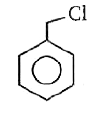Which one is most reactive towards SN1 reaction?
C6H5CH(C6H5)Br
C6H5CH(CH3)Br
C6H5C(CH3)(C6H5)Br
C6H5CH2Br
The correct Answer is:C
To determine which compound is most reactive towards an SN1 reaction, we need to analyze the stability of the carbocations formed during the reaction. The stability of a carbocation is influenced by factors such as inductive effects and resonance.
1. Understanding SN1 Reaction:
- SN1 (Substitution Nucleophilic Unimolecular) reactions involve the formation of a carbocation intermediate. The rate of the reaction depends on the stability of this carbocation.
2. Identify the Compounds:
- We need to evaluate the given compounds (not specified in the question) to determine which one forms the most stable carbocation.
3. Carbocation Stability:
- Carbocation stability increases in the following order:
- Methyl < Primary < Secondary < Tertiary
- Additionally, resonance and inductive effects can further stabilize carbocations.
4. Analyzing the Given Options:
- Option 1: If it forms a primary carbocation, it will be less stable.
- Option 2: If it forms a secondary carbocation, it will be more stable than a primary one.
- Option 3: If it has two benzene rings and an alkyl group (like CH3), it will benefit from resonance stabilization and inductive effects, making it highly stable.
- Option 4: If it forms a tertiary carbocation, it will be stable, but not as much as the one with resonance from benzene rings.
5. Conclusion:
- Based on the analysis, the compound in Option 3, which has two benzene rings and an alkyl group, will be the most stable due to resonance and inductive effects. Therefore, it will be the most reactive towards an SN1 reaction.
Final Answer:
The most reactive compound towards an SN1 reaction is Option 3.
- SN1 (Substitution Nucleophilic Unimolecular) reactions involve the formation of a carbocation intermediate. The rate of the reaction depends on the stability of this carbocation.
- We need to evaluate the given compounds (not specified in the question) to determine which one forms the most stable carbocation.
- Carbocation stability increases in the following order:
- Methyl < Primary < Secondary < Tertiary
- Additionally, resonance and inductive effects can further stabilize carbocations.
- Option 1: If it forms a primary carbocation, it will be less stable.
- Option 2: If it forms a secondary carbocation, it will be more stable than a primary one.
- Option 3: If it has two benzene rings and an alkyl group (like CH3), it will benefit from resonance stabilization and inductive effects, making it highly stable.
- Option 4: If it forms a tertiary carbocation, it will be stable, but not as much as the one with resonance from benzene rings.
- Based on the analysis, the compound in Option 3, which has two benzene rings and an alkyl group, will be the most stable due to resonance and inductive effects. Therefore, it will be the most reactive towards an SN1 reaction.
The most reactive compound towards an SN1 reaction is Option 3.
Similar Questions
Knowledge Check
Which of the following is most reactive towardSN2 reaction ?
A B
B C
C D
D
Which of the following is most reactive towardSN2 reaction ?
ACH2=CH−CH2−ClBPh−CH2−ClC DPh−C∣∣O−CH2−Cl
DPh−C∣∣O−CH2−Cl
The most reactive towards SN1 is:
View SolutionWrite the structure of an isomer of compound C4H9Br which is most reactive towards SN1 reaction.
View SolutionMost reactive halide towards SN1 reactions is
View SolutionThe following compounds are given to you
2-Bromopentane,2-Bromo-2-methylbutane,1-Bromopentane
(a) Write the compound which is most reactive towards SN2 reaction.
(b) Write the compound which is optically active.
(c). Write the compound which is most reactive towards β-elimination reaction.
View SolutionFollowing compounds are given to you :
2-Bromopentane, 2-Bromo-2-methylbutane, 1-Bromopentane
(i) Write the compound which is most reactive towards SN2 reaction
(ii) Write the compound which is optically active
(iii) Write the compound which is most reactive towards β-elimination reaction
View SolutionWhich among the following compounds wil be most reactive for SN1 reaction ?
View Solution
